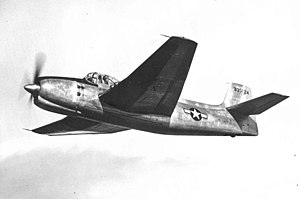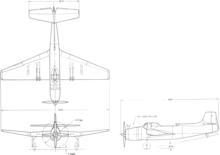Design and development
The Vultee engineering team decided early in the design process to build the XA-41 (company Model 90) around the 3,000 hp Pratt & Whitney R-4360 Wasp Major four-row, 28-cylinder radial engine. The Model 90's large tapered wing resembled that of Vultee Model 72 – a two-seat attack aircraft/dive bomber better known as the Vultee Vengeance (A-31/A-35) – including a straight leading edge, forward-swept trailing edge, and pronounced dihedral on the outer wing panels.
Designed to carry both a large internal load and external stores, the XA-41 was large for a single-engine aircraft. The single-place cockpit, set in line with the wing root, was 15 ft (4.6 m) off the ground when the airplane was parked.
As operational priorities shifted during its development phase, the original order for two XA-41 prototypes was cancelled, although the USAAF pressed for the completion of one prototype as an engine testbed for the R-4360 (the same engine used by the Boeing B-50 Superfortress).

The Douglas XTB2D Skypirate was a torpedo bomber intended for service with the United States Navy's Midway- and Essex-class aircraft carriers; it was too large for earlier decks. Two prototypes were completed, but the dedicated torpedo bomber was becoming an outdated concept, and with the end of World War II, the type was deemed unnecessary and cancelled.

The Zivko Edge 540 manufactured by Zivko Aeronautics is a highly aerobatic aircraft. Capable of a 420 degree per second roll rate and a 3,700 foot per minute climb rate, it has been flown to victory on the international Unlimited aerobatics circuit several times since the mid-1990s. A tandem-seat version is sold as the Edge 540T.

The Seversky XP-41 was a fighter aircraft built in the United States in 1939. A single prototype was modified from the last production Seversky P-35 by adding a new streamlined canopy, a Pratt & Whitney R-1830-19 engine with a two-speed supercharger, and revised landing gear. The XP-41 first flew in March 1939. The aircraft was developed in parallel with the P-43 Lancer, and work was stopped when the USAAC showed a preference for the latter.

The Republic XP-72 was an American prototype fighter-interceptor developed by Republic Aircraft as a progression of the P-47 Thunderbolt design. The XP-72 was designed around the Pratt & Whitney R-4360 Wasp Major 28-cylinder air-cooled radial engine with a supercharger mounted behind the pilot and driven by an extension shaft from the engine. The armament consisted of six .50 caliber (12.7 mm) wing-mounted Browning AN/M2 machine guns and underwing racks for two 1,000 lb bombs; Alternative armament packages included two 37 mm M4 autocannons with four .50 caliber AN/M2s, or four M4 autocannons.

The Vultee V-11 and V-12 were American stressed-skin monocoque monoplane attack aircraft of the 1930s. Developed from the Vultee V-1 single-engined airliner, the V-11 and V-12 were purchased by several nations for their armed forces, including China, who used them in combat against Japanese forces in the Second Sino-Japanese War. The United States Army Air Corps purchased seven V-11s as the YA-19 in the years before World War II, testing them to gather data to compare against twin engine light attack aircraft.
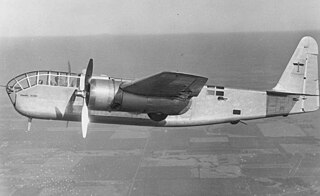
The Stearman XA-21 was a competitor in a United States Army Air Corps competition for a twin-engined attack aircraft which led to the Douglas A-20 Havoc, Martin A-22 Maryland and North American B-25 Mitchell.
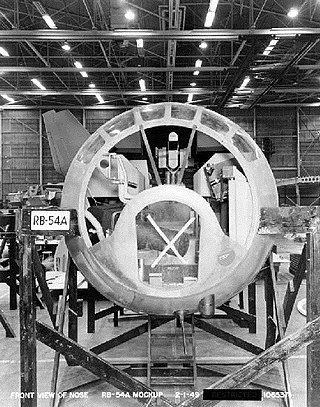
The Boeing B-54 was an American strategic bomber designed by Boeing for use by the United States Air Force. Derived from the YB-50C Superfortress, construction of the prototype was canceled before completion, and the aircraft was never flown.
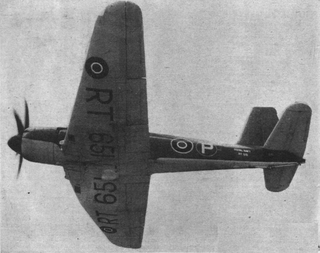
The Blackburn B.48 Firecrest, given the SBAC designation YA.1, was a single-engine naval strike fighter built by Blackburn Aircraft for service with the British Fleet Air Arm during the Second World War. It was a development of the troubled Firebrand, designed to Air Ministry Specification S.28/43, for an improved aircraft more suited to carrier operations. Three prototypes were ordered with the company designation of B-48 and the informal name of "Firecrest", but only two of them actually flew. The development of the aircraft was prolonged by significant design changes and slow deliveries of components, but the determination by the Ministry of Supply in 1946 that the airframe did not meet the requirements for a strike fighter doomed the aircraft. Construction of two of the prototypes was continued to gain flight-test data and the third was allocated to strength testing. The two flying aircraft were sold back to Blackburn in 1950 for disposal and the other aircraft survived until 1952.
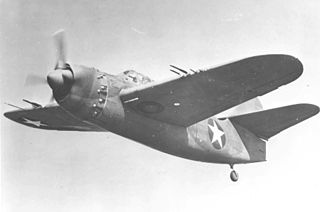
The Brewster XA-32 was an American attack aircraft, a mid-wing type with an internal bomb bay. The prototype had the R-2800 engine, but it could take the intended R-4360 powerplant. After a dismal set of test results, the XA-32 did not enter production.

The Curtiss XBTC was a prototype single-seat, single-engined torpedo/dive bomber developed during World War II for the United States Navy. Four aircraft were ordered, powered by two different engines, but the two aircraft to be fitted with the Wright R-3350 radial engine were cancelled in late 1942, leaving only the pair using the Pratt & Whitney R-4360 radial. By this time, Curtiss Aircraft was overwhelmed with work and the Navy gave the XBTC-2 prototypes a low priority which delayed progress so the first flight did not take place until the beginning of 1945. One aircraft crashed in early 1947 and the other was disposed of later that year.

The Letov Š-50 was a 1930s prototype Czechoslovakian military general-purpose monoplane, designed and built by Letov.

The XtremeAir Sbach 342 (XA42) is a German high performance two-seat aerobatic and touring monoplane designed by Philipp Steinbach with Albert Mylius and built by XtremeAir GmbH of Hecklingen.

The Breese-Dallas Model 1 or Breese model X was a prototype single engine airliner that rapidly changed hands throughout the 1930s. It was also known as the Michigan Aircraft Company Model 1, and the Lambert Model 1344.
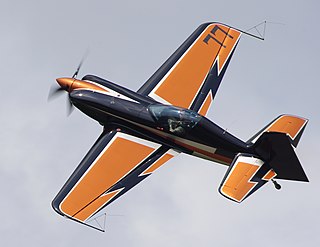
The XtremeAir Sbach 300 is a German aerobatic aircraft, designed by Philippe Steinbach and produced by XtremeAir, of Cochstedt. The aircraft is supplied as a complete ready-to-fly-aircraft.
The Bagalini Colombo is an Italian homebuilt aircraft that was designed by Marino Bagalini. The aircraft is supplied in the form of plans for amateur construction.
The Historical P-51 Mustang is an American homebuilt aircraft that was designed and produced by the Historical Aircraft Corporation of Nucla, Colorado. The aircraft is a 62.5% scale replica of the original North American P-51 Mustang and when it was available was supplied as a kit for amateur construction.
The Storm 320E, sometimes written Storm 320 E, is an Italian microlight aircraft that was designed and produced by Storm Aircraft of Sabaudia. Storm Aircraft was originally called SG Aviation srl. When it was available the aircraft was supplied as a kit for amateur construction.

The InterPlane Starboy was a proposed Czech homebuilt aircraft designed by InterPlane Aircraft of Zbraslavice. The aircraft was intended to be supplied as a complete ready-to-fly-aircraft or as a kit for amateur construction, but none seem to have been built.
The Bilsam Ultra Cruiser is a family of Polish microlight aircraft designed and produced by Bilsam Aviation of Poznań, introduced in the 2000s. The aircraft is supplied as a complete ready-to-fly-aircraft, as a kit and in the form of plans for amateur construction.
The Vought V-326 was an American experimental aircraft used by Pratt & Whitney as a high altitude engine test bed.
